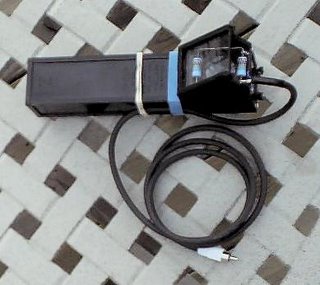I had brought down to Mom's the two large 2 watt 220 ohm resistors from Toronto. I used their heavy, thick lead wires to form a box frame that fit inside the Telrad uprights above the lens which support the glass plate. It was a perfect fit. There is a little bit of friction so the heater will stay in place but is easily removed, for use elsewhere, and for stowage.

I connected the two resistors in parallel so to yield 110 ohms. This is in turn connected by professional grade 4-wire microphone cable. I used 2 wires for each side of the circuit, for redundancy, and to reduce resistance from the cable itself. I borrowed my sister's heat gun to work the shrink tubing but I over did it on the high setting! Oops.
Finally, I connected an RCA male plug at the end. I had bought a pack of RCA plugs from The Source. Cheapo ones, not gold-plated, since—it occurred to me—this was not a high-end audiophile application. And also because I could not find nickel-plated ones (like Kendrick uses) or ones with openings large enough to fit the thick microphone cable. The plugs have coloured covers: white, yellow, blue, and red; two of each. Maybe I can use the colouring deliberately. I decided on white for the Telrad plug.

The assembly proper I completed a couple of days ago after some mock-up testing. It worked well.
Early today I bought some self-adhesive cable hooks from Canadian Tire (not shown). They work perfectly, fitting around the cable casing well. I only wish they were black. The hooks are designed well so to prevent the cable from slipping out. I used two of them to offer good strain relief as the cord loops from the side of the Telrad up into the lens/plate area.
Tonight, I did a field test. I put the Telrad outside at 8:00pm for about 45 minutes. Temperature was around 1 or 2°C, right around the dew point. The light breeze dropped the temp another degree or so. When I returned, it was dewed up. The glass and the lens were coated with a thin layer of water. I plugged my heater into the Kendrick controller which I turned up to its maximum setting. Within 30 seconds, I could see the dew clearing from the bottom edge of the glass. I dropped the controller setting to Medium and left it for a couple of minutes. On examination, the glass plate and lens were completely clear. Wahoo!
So, I completed my first custom dew-fighting heater. I'm quite pleased with the result.
Mom is happy too, oddly. Funny, she's never hauled out the telescope on her own.
§
Checked the fuse in my first generation Kendrick dew heater controller: 5 amp.
I understand I can bump this to 7 amp.
§
Replaced the casters on Mom's telescope dolley. The old casters were too small. There "new" ones are almost twice the size and work a lot better, a lot smoother.


No comments:
Post a Comment